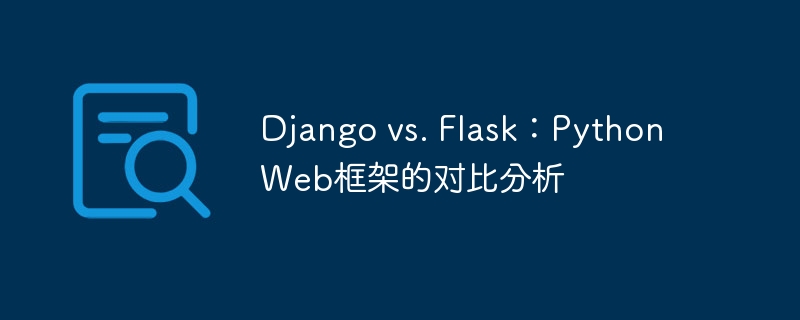Home >Backend Development >Python Tutorial >Django vs. Flask: A comparative analysis of Python web frameworks
Django vs. Flask: A comparative analysis of Python web frameworks
- WBOYWBOYWBOYWBOYWBOYWBOYWBOYWBOYWBOYWBOYWBOYWBOYWBOriginal
- 2024-01-19 08:36:051369browse

Django and Flask are both leaders in Python web frameworks. They both have their own advantages and applicable scenarios. This article will conduct a comparative analysis of these two frameworks and provide specific code examples.
- Development Introduction
Django is a full-featured Web framework, its main purpose is to quickly develop complex Web applications. Django provides many built-in functions, such as ORM (Object Relational Mapping), forms, authentication, management backend, etc. These features make Django very advantageous in handling large-scale web applications.
Flask is a lightweight web framework, its main purpose is to provide an easy way to quickly build web applications. Unlike Django, the core of Flask only contains the simplest functions, such as routing, request context, sessions, templates, etc. This allows developers to customize their own frameworks.
- Framework structure
Most of Django’s functions are composed of various built-in applications. The functions of these applications vary, but they are all composed according to Django's rules. For example, Django's ORM application is provided by Django itself, the template application is provided by Django itself, and Django's form application is provided by a third party. Through the combination of these applications, we can quickly complete the construction of Web applications.
Flask's framework structure is relatively free, and we can organize our own application structure as needed. For example, we can create a directory named "main", place all routes, templates, and static files in this directory, and then initialize it through an instance of Flask. You can also create different Blueprints, place different functional modules in different Blueprints, and then use Flask instances to combine them.
- Routes
In Django, routes are defined by urlconf, which is a mapping of discovery URLs and corresponding views. For a given URL, Django will sequentially find its matching URL in the urlconf and map it to the corresponding view, while passing the relevant parameters.
In Flask, routes are defined by decorators. A decorator contains a URL path and its corresponding function. For example, the following is a route definition in a Flask application:
from flask import Flask
app = Flask(__name__)
@app.route('/hello')
def hello():
return 'Hello, World!'This code defines a route that, when accessing the /hello path, will call the hello function and return the "Hello, World!" string .
- Database
Django has a built-in ORM (Object Relational Mapping), which provides support for a variety of databases. Based on ORM, we can use Python code to define the data model, and can easily perform addition, deletion, modification and query operations.
Flask does not have a built-in ORM, but it works well with several excellent ORMs. For example, we can use SQLAlchemy as an ORM to perform database operations. The following is a Flask sample code that uses SQLAlchemy for database query:
from flask import Flask
from flask_sqlalchemy import SQLAlchemy
app = Flask(__name__)
app.config['SQLALCHEMY_DATABASE_URI'] = 'mysql://user:password@localhost/test'
db = SQLAlchemy(app)
class User(db.Model):
id = db.Column(db.Integer, primary_key=True)
username = db.Column(db.String(80), unique=True, nullable=False)
email = db.Column(db.String(120), unique=True, nullable=False)
def __repr__(self):
return '<User %r>' % self.username
@app.route('/user')
def user_detail():
user = User.query.filter_by(username='john').first()
return 'User email is ' + user.emailIn this code, we define a User object, which inherits from db.Model. Then we use SQLAlchemy's query language to query user data that meets the conditions through User.query.filter_by.
- Template engine
Django provides a built-in template engine, which makes it very convenient for us to design templates. The Django template engine provides many built-in tags and filters for efficient template rendering.
Flask does not have a built-in template engine. Developers can use excellent template engines such as Jinja2 to process templates. The following is a Flask sample code that uses Jinja2 template rendering:
from flask import Flask, render_template
app = Flask(__name__)
@app.route('/hello')
@app.route('/hello/<name>')
def hello(name=None):
return render_template('hello.html', name=name)In this code, we use the render_template function to render the hello.html template. Jinja2 template tags can be used in hello.html to render dynamic content.
- Summary
Django and Flask are both excellent frameworks among Python web frameworks. They each have their own advantages and applicable scenarios. If we need to develop a complex web application, Django may be more suitable. And if we just need to quickly build a small web application, Flask may be better. In actual development, we can choose the appropriate framework according to our needs.
In the code examples, we use keywords such as ORM and template engine. Their specific implementation requires code writing, and the article needs to show the differences through specific example codes. Through specific code samples, readers can better understand the differences between Django and Flask.
The above is the detailed content of Django vs. Flask: A comparative analysis of Python web frameworks. For more information, please follow other related articles on the PHP Chinese website!

